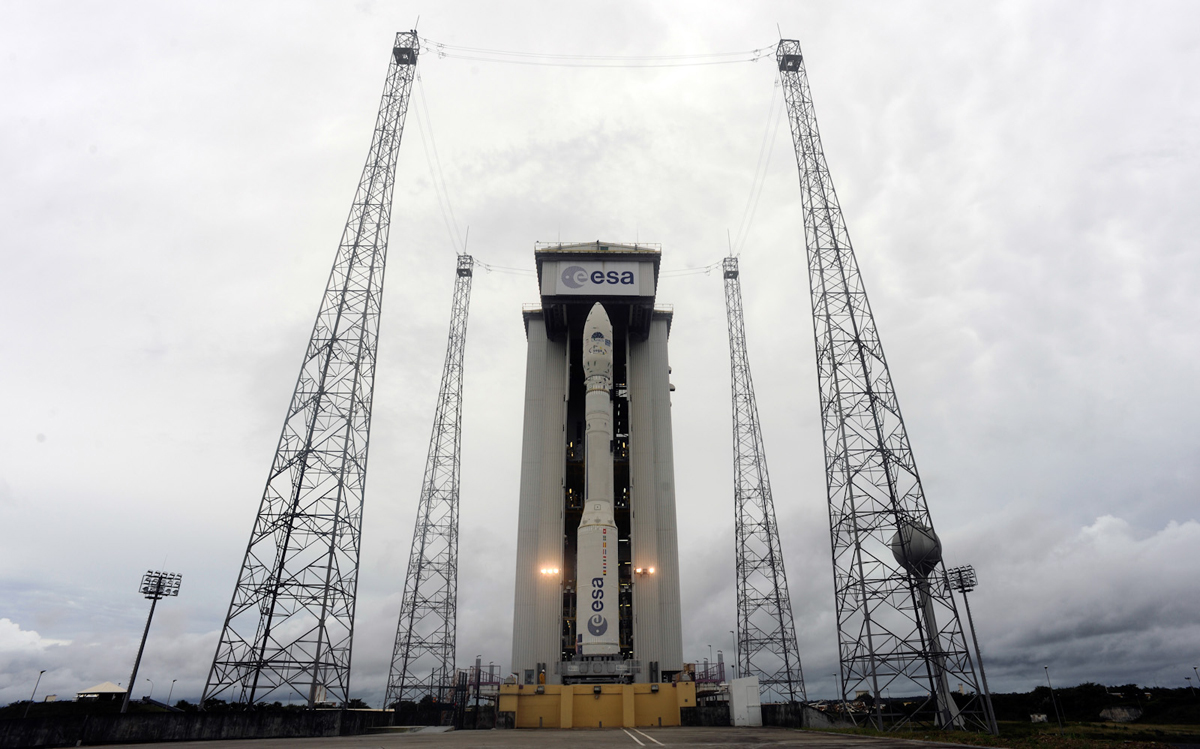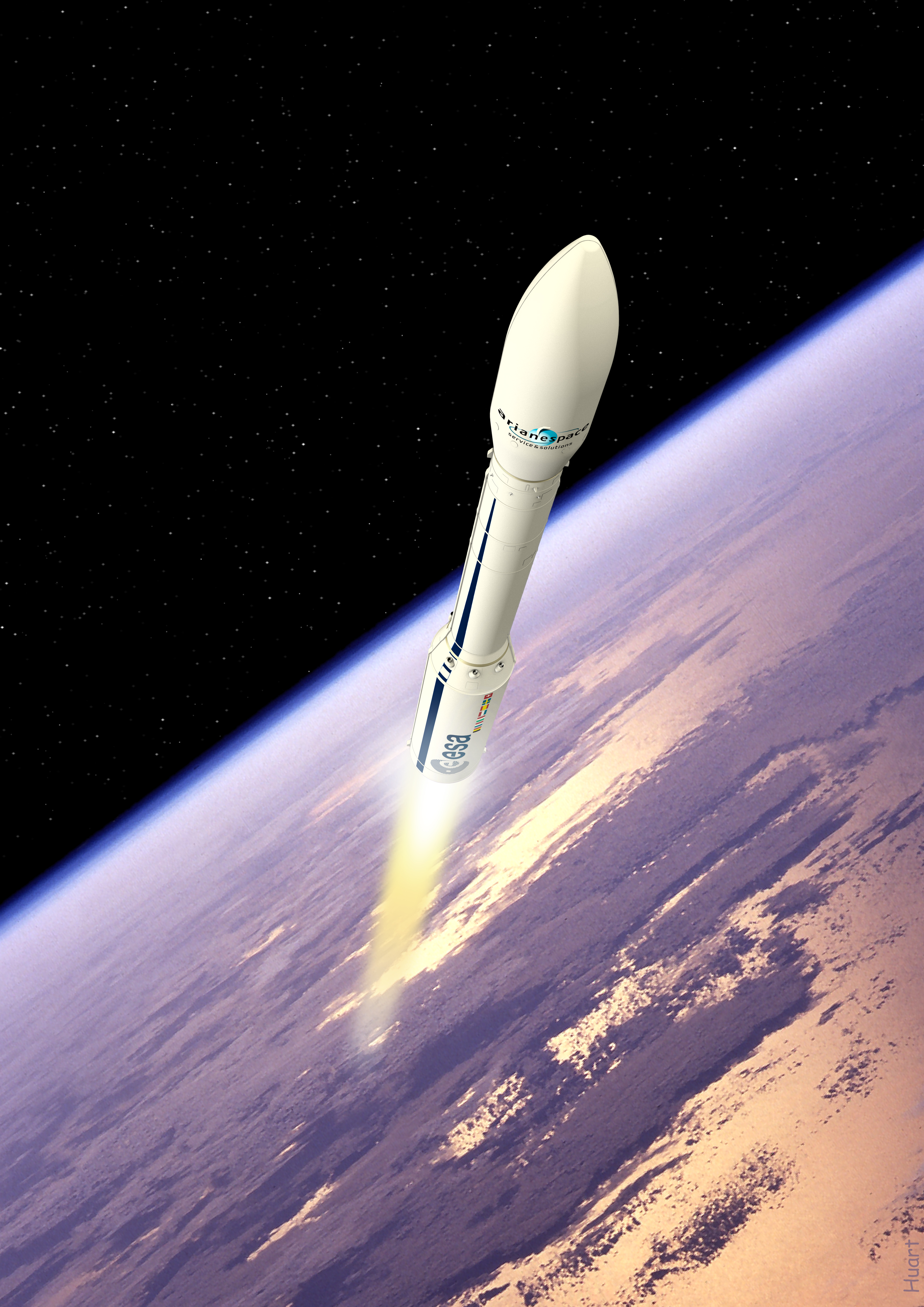Europe's Newest Rocket to Launch on Maiden Voyage Monday

The new Vega rocket from Europe may be small, but it promises to do the job of at least twice that of most other rockets its size.
The European Space Agency's (ESA) first Vega rocket is now fully assembled on its launchpad at Europe's spaceport in French Guiana, on the northern Atlantic coast of South America. Vega's maiden launch, dubbed VV01, is expected to occur on Feb. 13. The launch window extends from 5:00 a.m. to 7:00 a.m. EST (1000 to 1200 GMT).
The Vega rocket is named after the second-brightest star in the northern hemisphere. The booster stands about 100 feet (30 meters) tall and 10 feet (3 m) wide, and weighs a total of 137 metric tons at liftoff. The rocket is made up of four stages — three solid-propellant stages and a fourth stage, called AVUM, that carries the payload.
Vega is designed to be a small launcher, complementing the existing fleet of medium-size Soyuz rockets and the larger Ariane 5 boosters that already launch from French Guiana.
While there is a growing trend toward larger satellites, there is still a need for small launchers to place 660 to 4,400-pound (300 to 2,000-kilogram) satellites into orbit — typically on scientific and Earth-observation missions. [Photos: Meet Vega, Europe's New Rocket]
"Vega will complete the possibilities for space launch for Europe," Antonio Fabrizi, director of launchers at ESA, told SPACE.com.
Unlike most small rockets, Vega is able to place multiple payloads into different orbits. The rocket is capable of handling payloads ranging from a lone satellite up to one main satellite plus six microsatellites — ones that are about 22 to 220 pounds (10 to 100 kg) in size. Overall, Vega can launch a payload mass ranging up to about 5,500 pounds (2,500 kg).
Breaking space news, the latest updates on rocket launches, skywatching events and more!
"Vega demonstrates new technology that might get considered when evolving Ariane launchers or even totally new launchers," Fabrizi said.

The inaugural Vega flight will carry nine satellites into orbit. These include:
- LARES, the Laser Relativity Satellite. The solid tungsten sphere, which weighs about 860 pounds (390 kg), will focus on how Earth's spin warps space around the planet, a phenomenon known as the Lense–Thirring effect. LARES will measure this phenomenon 10 times better than previous missions Lageos-1 and Lageos-2.
- ALMASat-1, the Alma Mater Satellite. ALMA-Sat-1 is a 27.5-pound (12.5 kg) microsatellite that will test how well this system might perform for future missions such as Earth observation.
- Seven CubeSats, which are each so-called nanosatellites about 2.2 pounds (1 kg) in size. These have been developed by more than 250 university students from six different countries over the last four years. These nanosatellites are as follows:
- Xatcobeo is a mission to demonstrate software-defined radio and solar panel deployment.
- Robusta is a mission to test and evaluate the effects of low levels of radiation effects on transistors.
- e-st@r is a demonstration of an active three-axis attitude determination and control system, including an inertial measurement unit.
- Goliat will image Earth using a digital camera, and also measure radiation levels and micrometeoroids.
- PW-Sat is a mission to test an atmospheric drag augmentation device for de-orbiting CubeSats.
- MaSat-1 is a mission to demonstrate various spacecraft avionics, including a power conditioning system, transceiver and onboard data handling.
- UniCubeSat GG is a mission to study gravity gradients.
Vega's fourth stage, AVUM, will first reach a circular orbit at an altitude of 900 miles (1,450 kilometers) to release LARES. It will then maneuver to as low as 217 miles (350 km) before deploying the other satellites.
If the first Vega launch goes well, it will pave the way for future ESA missions, as well as the commercial launch of two Earth-observing Sentinel satellites. ESA spent 700 million Euros (about $930 million) developing Vega, and the next five flights should cost another 300 million Euros (about $399 million).
"Once we've demonstrated that we can serve many different types of missions, I expect we should have a market of two to three launches per year," Fabrizi said.
The Vega launch can be watched live via ESA's webcast here or see live countdown updates from Spaceflight Now. Follow SPACE.com for the latest in space science and exploration news on Twitter @Spacedotcom and on Facebook.
Join our Space Forums to keep talking space on the latest missions, night sky and more! And if you have a news tip, correction or comment, let us know at: community@space.com.

Charles Q. Choi is a contributing writer for Space.com and Live Science. He covers all things human origins and astronomy as well as physics, animals and general science topics. Charles has a Master of Arts degree from the University of Missouri-Columbia, School of Journalism and a Bachelor of Arts degree from the University of South Florida. Charles has visited every continent on Earth, drinking rancid yak butter tea in Lhasa, snorkeling with sea lions in the Galapagos and even climbing an iceberg in Antarctica. Visit him at http://www.sciwriter.us
